
Bees are winged insects closely related to wasps and ants, known for their roles in pollination and, in the case of the best-known bee species, the western honey bee, for producing honey. Bees are a monophyletic lineage within the superfamily Apoidea. They are currently considered a clade, called Anthophila. There are over 20,000 known species of bees in seven recognized biological families. Some species – including honey bees, bumblebees, and stingless bees – live socially in colonies while most species (>90%) – including mason bees, carpenter bees, leafcutter bees, and sweat bees – are solitary.

Megachile rotundata, the alfalfa leafcutting bee, is a European bee that has been introduced to various regions around the world. As a solitary bee species, it does not build colonies or store honey, but is a very efficient pollinator of alfalfa, carrots, other vegetables, and some fruits. Because of this, farmers often use M. rotundata as a pollination aid by distributing M. rotundata prepupae around their crops. Each female constructs and provisions her own nest, which is built in old trees or log tunnels. Being a leafcutter bee, these nests are lined with cut leaves. These bees feed on pollen and nectar and display sexual dimorphism. This species has been known to bite and sting, but it poses no overall danger unless it is threatened or harmed, and its sting has been described as half as painful as a honey bee's.

Megachilidae is a cosmopolitan family of mostly solitary bees. Characteristic traits of this family are the restriction of their pollen-carrying structure to the ventral surface of the abdomen, and their typically elongated labrum. Megachilid genera are most commonly known as mason bees and leafcutter bees, reflecting the materials from which they build their nest cells ; a few collect plant or animal hairs and fibers, and are called carder bees, while others use plant resins in nest construction and are correspondingly called resin bees. All species feed on nectar and pollen, but a few are kleptoparasites, feeding on pollen collected by other megachilid bees. Parasitic species do not possess scopae. The motion of Megachilidae in the reproductive structures of flowers is energetic and swimming-like; this agitation releases large amounts of pollen.

A worker bee is any female (eusocial) bee that lacks the full reproductive capacity of the colony's queen bee; under most circumstances, this is correlated to an increase in certain non-reproductive activities relative to a queen. While worker bees occur in all eusocial bee species, the term is rarely used for any bees other than honey bees.

Osmia lignaria, commonly known as the orchard mason bee or blue orchard bee, is a megachilid bee that makes nests in natural holes and reeds, creating individual cells for its brood that are separated by mud dividers. Unlike carpenter bees, it cannot drill holes in wood. O. lignaria is a common species used for early spring fruit bloom in the United States and Canada, though a number of other Osmia species are cultured for use in pollination.

The European beewolf, also known as the bee-killer wasp or the bee-eating philanthus, is a solitary wasp that lives in the Western Palearctic and Afrotropics. Although the adults of the species are herbivores, the species derives its name from the behaviour of the inseminated females, who hunt Western honey bees. The female places several of its paralysed prey together with an egg in a small underground chamber, to serve as food for the wasp larvae. All members of the genus Philanthus hunt various species of bees, but P. triangulum is apparently the only one that specialises in Western honey bees.
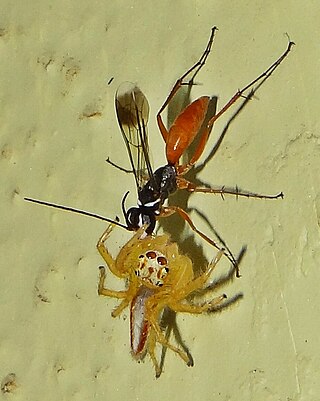
Mass provisioning is a form of parental investment in which an adult insect, most commonly a hymenopteran such as a bee or wasp, stocks all the food for each of her offspring in a small chamber before she lays the egg. This behavior is common in both solitary and eusocial bees, though essentially absent in eusocial wasps.

The tawny mining bee, Andrena fulva, is a European species of the sand bee (Andrena) genus. The males are 10–12 mm (0.4–0.5 in) and the females 8–10 mm (0.3–0.4 in) long. The female is covered with fox-red hair on the dorsal surface of its thorax and abdomen and black hair on its head and ventral surface. The male is less distinctive, being clad in golden-brown or reddish-brown hairs, with some long white hairs on the face, and a tooth on each of the mandibles.

Megachile perihirta, commonly known as the Western leafcutting bee, is a bee in the genus Megachile. The bee is native to western North America, ranging from Nebraska to Texas and Mexico, west to California, and north to British Columbia and Alberta, and often inhabits meadows and orchards. The bee is black with long whitish-yellow hair, more so below the thorax and abdomen. The abdomen, however, is mostly bare, although each segment has scattered whitish hair. The wings of the Western leafcutting bee are clear, while their veins are black. The pollen basket below the abdomen is bright red.
Andrena salicifloris, or the willow flower miner bee, is a miner bee in the genus Andrena. Another common name for this species is the willow mining bee. The bee ranges from Colorado to California and north to British Columbia, and often inhabits arid and alpine lands. The bee is often black or dark brown, and is sparsely coated with grayish hair on the thorax, legs and on the abdomen. The pollen basket is on most of the hind leg. The wings of the willow flower miner bee are smokey, and their veins are black.

Megachile fidelis, the faithful leafcutting bee, is a species of bee in the family Megachilidae.
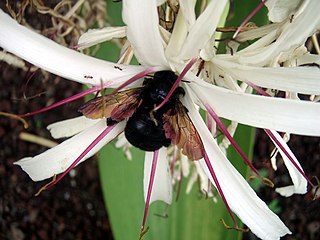
Xylocopa sonorina, the valley carpenter bee or Hawaiian carpenter bee, is a species of carpenter bee found from western Texas to northern California, and the eastern Pacific islands. Females are black while males are golden-brown with green eyes.

Bombus fervidus, the golden northern bumble bee or yellow bumblebee, is a species of bumblebee native to North America. It has a yellow-colored abdomen and thorax. Its range includes the North American continent, excluding much of the southern United States, Alaska, and the northern parts of Canada. It is common in cities and farmland, with populations concentrated in the Northeastern part of the United States. It is similar in color and range to its sibling species, Bombus californicus, though sometimes also confused with the American bumblebee or black and gold bumblebee. It has complex behavioral traits, which includes a coordinated nest defense to ward off predators. B. fervidus is an important pollinator, so recent population decline is a particular concern.
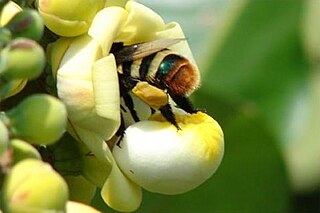
Eulaema meriana is a large-bodied bee species in the tribe Euglossini, otherwise known as the orchid bees. The species is a solitary bee and is native to tropical Central and South America. The male collects fragrances from orchid flowers, which it stores in hollows in its hind legs. Orchids can be deceptive by mimicking the form of a female and her sex pheromone, thus luring male bees or wasps. Pollination will take place as the males attempt to mate with the labellum, or the tip petal of the flower. Male E. meriana are territorial and have a particular perch on a tree trunk where it displays to attract a female. After mating, the female builds a nest with urn-shaped cells made with mud, feces, and plant resin, and provisions these with nectar and pollen before laying an egg in each. These bees also have complex foraging and wing buzzing behaviors and are part of a mimicry complex.

Coelioxys, common name leaf-cutting cuckoo bees or sharp-tailed bees, is a genus of solitary kleptoparasitic cuckoo bees belonging to the family Megachilidae.
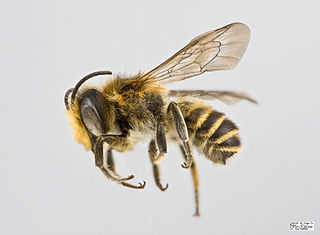
Megachile centuncularis, commonly known as the patchwork leafcutter bee, is a species of bee in the family Megachilidae. It was first described by the Swedish naturalist Carl Linnaeus in 1758.
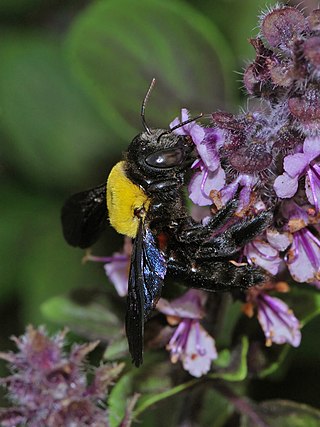
Xylocopa pubescens is a species of large carpenter bee. Females form nests by excavation with their mandibles, often in dead or soft wood. X. pubescens is commonly found in areas extending from India to Northeast and West Africa. It must reside in these warm climates because it requires a minimum ambient temperature of 18 °C (64 °F) in order to forage.

Macropis nuda is a ground nesting, univoltine bee native to northern parts of North America. Thus, this species cocoons as pupae and hibernates over the winter. The species is unusual as it is an oligolectic bee, foraging exclusively for floral oils and pollen from Primulaceae of the species Lysimachia ciliata.

Macrotera portalis is a species of communal, ground nesting, partially bivoltine bees found in arid grasslands and desert regions of North America. An oligolectic bee, M. portalis gathers pollen only from plants in the genus Sphaeralcea and has patterns of seasonal emergence to survive the harsh conditions of the desert, with emergence delayed until monsoon rains arrive.

Trachusa byssina is a species of bees within the genus Trachusa.



















